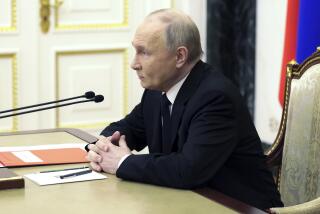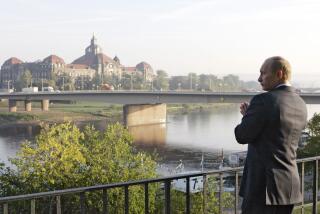RUSSIA : Museum Visitors Shy Away From Pact With Nazis, Secret Protocols : Exhibited map signed by Stalin divvying up Eastern Europe casts pall over pride in World War II victory.
MOSCOW — Like a boorish relative disrupting a lavish wedding, an exhibit of the secret protocols of the 1939 German-Soviet nonaggression pact is inflicting a moment of embarrassment in this season of celebrations marking 50 years since Nazi Germany’s defeat.
Among the most dastardly documents penned by dictator Josef Stalin during his three-decade reign of terror, the supplements to the nonaggression pact split Eastern Europe into “spheres of influence,” setting up the Nazi invasion of Poland and Soviet annexation of the Baltic states.
Millions of Poles, Baltic citizens, Jews and non-Communists died or suffered Siberian exile as a consequence of the carve-up that Soviet leaders denied until the soul-baring era of glasnost beginning in the late 1980s.
The original nonaggression pact concluded between then-Soviet Foreign Minister Vyacheslav M. Molotov and his Nazi counterpart, Joachim von Ribbentrop, is being shown to the public for the first time in its 56-year history in the “Documents of the Great War” exhibit at Moscow’s premier art venue, the Tretyakov Gallery.
The pact was supposed to have spared Russians the fate suffered by the rest of Eastern Europe, but in the end caught them unawares when the Nazis invaded two years later.
While the disclosure of the Molotov-Ribbentrop pact was surprising in itself, it is the long-denied protocols and an accompanying map outlining the dictators’ divvying up of whole nations that has cast a spiritual pall over the exhibit and the rare sense of national pride felt by Russians as the half-century anniversary of their triumph approaches.
Stalin has long been revered by Russians as the brilliant supreme commander who spearheaded the battle against the Nazis.
His signature on the German-language map provides disturbing evidence of his early complicity with the forces of fascism whose 1941 invasion led to the wartime deaths of 20 million Soviets.
Visitors to the gallery show little interest in the documents of duplicity, shying away from the bold disclosure out of chagrin.
“I suppose it’s necessary to show both sides of our late leader,” conceded 63-year-old pensioner Lyudmila Tarakanova, casting a suspicious glance at the secret protocols she had swiftly passed by. “We know Stalin committed great crimes against the people. Our eyes have been opened. But Russians must respect his contributions in the eventual victory over fascism. We should fairly judge his good deeds as well as the bad.”
Attendance has been light since the exhibit opened on Defenders of the Fatherland Day, the Feb. 23 holiday in honor of Russian soldiers. Moscow newspapers have carried no word of the unwelcome reminders, an uncharacteristic silence for media usually excessive in their coverage of art and historical displays.
Other items in the 400-piece exhibit chronicle the execution by Soviet troops of thousands of Polish soldiers in the village of Katyn, as well as the systematic repressions, deportations and killings of Jews and anti-Communist resisters that accompanied the Soviet seizure of Estonia, Latvia and Lithuania.
*
One gallery visitor taking a long look at the historic documents was Wojciech Grauzhenis, a Lithuanian-born Pole showing his young son the traces of a conspiracy that sealed the fate of Eastern Europe.
“Finally the world can see what really happened,” said the visitor from now-independent Lithuania.
But an elderly male visitor had his own view: “If (Stalin) hadn’t signed with Hitler, we would have been attacked two years earlier, when we had no chance to fight back.”
More to Read
Sign up for The Wild
We’ll help you find the best places to hike, bike and run, as well as the perfect silent spots for meditation and yoga.
You may occasionally receive promotional content from the Los Angeles Times.







